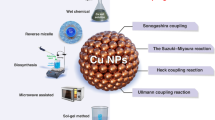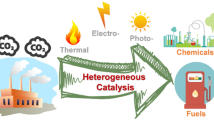Abstract
Rubidium promoted iron Fischer–Tropsch synthesis (FTS) catalysts were prepared with two Rb/Fe atomic ratios (1.44/100 and 5/100) using rubidium nitrate and rubidium carbonate as rubidium precursors. Results of catalytic activity and deactivation studies in a CSTR revealed that rubidium promoted catalysts result in a steady conversion with a lower deactivation rate than that of the corresponding unpromoted catalyst although the initial activity of the promoted catalyst was almost half that of the unpromoted catalyst. Rubidium promotion results in lower methane production, and higher CO2, alkene and 1-alkene fraction in FTS products. Mössbauer spectroscopic measurements of CO activated and working catalyst samples indicated that the composition of the iron carbide phase formed after carbidization was χ-Fe5 C2 for both promoted and unpromoted catalysts. However, in the case of the rubidium promoted catalyst, ɛ′-Fe2.2C became the predominant carbidic phase as FTS continued and the overall catalyst composition remained carbidic in nature. In contrast, the carbide content of the unpromoted catalyst was found to decline very quickly as a function of synthesis time. Results of XANES and EXAFS measurements suggested that rubidium was present in the oxidized state and that the compound most prevalent in the active catalyst samples closely resembled that of rubidium carbonate.









Similar content being viewed by others
References
Ronald D, Bell AT (1986) J Catal 97:121
Ngantsoue-Hoc W, Zhang Y, O’Brien RJ, Luo M, Davis BH (2002) Appl Catal 236:77
Li S, Li A, Krishnamoorthy S, Iglesia E (2001) Catal Lett 77:197
Li S, Ding W, Meitzner GD, Iglesia E (2002) J Phys Chem B 106:85
Li S, Krishnamoorthy S, Li A, Meitzner GD, Iglesia E (2002) J Catal 206:202
Luo M, O’Brien RJ, Bao S, Davis BH (2003) Appl Catal A Gen 239:111
Arakawa H, Bell AT (1983) Ind Eng Chem Res Process Des Dev 22:97
Raje AP, O’Brien RJ, Davis BH (1998) J Catal 180:36
Bukur DB, Mukesh DS, Patal A (1990) Ind Eng Chem Res 29:194
Dictor RA, Bell AT (1986) J Catal 97:121
Miller DG, Moskovits M (1988) J Phys Chem 92:6081
Doskocil EJ, Bordawekar SV, Davis RJ (1997) J Catal 169:327
Tsuchiya S, Takase S, Imamura H (1984) Chem Lett 5:661
Tanabe K, Misono M, Ono Y, Hattori H (1989) New solid acids and bases. Kodansha, Tokyo
Ressler T (1997) WinXAS97 version 1.0
Niemantsverdriet JW, van der Krann AM, van Dijk WL, van der Baan HS (1980) J Phys Chem 84:3363
Butt JB (1990) Catal Lett 7:61
Dry ME (1981) In: Anderson JR, Boudart M (eds) Catalysis—science and technology. Springer-Verlag, New York, p 59
Huang C-S, Ganguly B, Huffman GP, Huggins FE, Davis BH (1993) Fuel Sci Technol Int 11(9):1289
Hofer LJE (1956) In: Emmett PH (ed) Catalysis, vol IV. Reinhold Publishing, New York, pp 373–442
Zarochak MF, McDonald MA (1986) Slurry-phase Fischer–Tropsch synthesis, CONF-86/288-1, Proceedings of indirect liquefaction contractor’s conference, Monroeville, PA, USA, December 2–4, 1986
Davis BH (1999) Technology development for iron Fischer–Tropsch catalysis, US DOE Final Technical Report, Contract # DE-AC22-94PC94055-13
Sarkar A, Seth D, dozier AK, Neathery JK, Hamdeh HH, Davis BH (accepted, in press) Catal Lett
Sarkar A, Dozier AK, Graham UM, Thomas G, O’Brien RJ, Davis BH (2007) Appl Catal A Gen 326:55
Rao KRPM, Huggins FE, Huffman GP, Gormley RJ, O’Brien RJ, Davis BH (1996) Energy Fuels 10:546
Rao KRPM, Huggins FE, Huffman GP, O’Brien RJ, Gormley RJ, Davis BH (1995) Prepr Pap ACS Div Fuel Chem 40(1):153
Li S, Meitzner GD, Iglesia E (2001) J Phys Chem B 105:5743
Acknowledgments
This work is supported by US DOE contract number DE-FC26-03NT41965 and the Commonwealth of Kentucky. The EXAFS/XANES experiments are carried out at the National Synchrotron Light Source, Brookhaven National Laboratory, which is supported by the US DOE, Divisions of Materials Science and Chemical Sciences. Special thanks to Dr. Syed Khalid (Beamline X18b, NSLS, Brookhaven) and Dr. Patricia M. Patterson, Center for Applied Energy Research, U of Kentucky, Lexington, KY for help with XAFS studies.
Author information
Authors and Affiliations
Corresponding author
Rights and permissions
About this article
Cite this article
Sarkar, A., Jacobs, G., Ji, Y. et al. Fischer–Tropsch Synthesis: Characterization Rb Promoted Iron Catalyst. Catal Lett 121, 1–11 (2008). https://doi.org/10.1007/s10562-007-9288-1
Received:
Revised:
Accepted:
Published:
Issue Date:
DOI: https://doi.org/10.1007/s10562-007-9288-1




